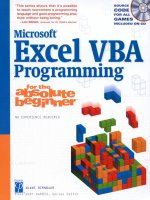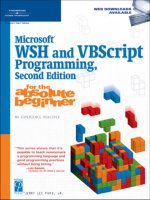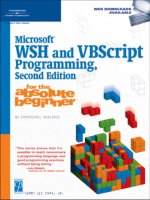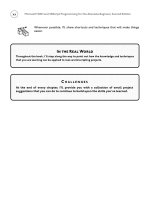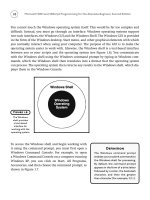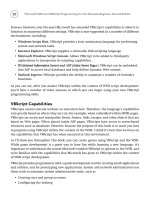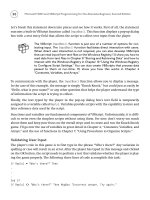Microsoft Excel VBA Programming for the Absolute Beginner Second Edition phần 6 pdf
Bạn đang xem bản rút gọn của tài liệu. Xem và tải ngay bản đầy đủ của tài liệu tại đây (1.37 MB, 50 trang )
19. The program shall evaluate the dealer’s and player’s scores and display a message
indicating the winner, or push if it’s a tie.
20. The program shall calculate and display the player’s balance from the amount of the
bet and the result of each hand.
21. The program shall output the result of each hand to the worksheet. The result con-
sists of the dealer’s and player’s final score, and the player’s new balance.
22. The program shall allow the player to quickly clear the results from the worksheet
from a click of a Command Button control located on the worksheet.
Designing Blackjack
This project uses many of the tools discussed in previous chapters of this book, including
various code structures and common ActiveX controls. In particular, the project includes
additional tools discussed in this chapter. These tools include UserForms and their code
modules, along with Frame, and Combo Box controls.
The Blackjack game runs from a VBA form that contains several ActiveX controls. The form is
separated into a Dealer area and a Player area using Frame controls. The dealer frame contains
these ActiveX controls:
• Five Image controls for displaying images of cards representing the dealer’s hand.
• A Combo Box control (used as a dropdown list) so the player can choose the number
of decks (52 cards per deck) used in the game.
• A Label control for displaying the score of the dealer’s hand.
The player frame contains these ActiveX controls:
• Five Image controls for displaying images of cards representing the player’s hand.
• A Combo Box control for the player to enter or select an amount to bet.
• A Label control for displaying the player’s score.
• A Label control for displaying the player’s current balance.
• A Command Button control for beginning and selecting a new game.
• A Command Button control for selecting another draw from the deck.
A single Label control displays the result of each hand. Figure 6.16 shows the Blackjack form
(named
frmTable) interface with the previously listed ActiveX controls. Table 6.6 lists the set-
tings of a few select properties of the ActiveX controls added to the Blackjack form. In most
instances, font, color, and size properties were also changed from their default values, but
are not listed in the table.
239
Chapter 6 • VBA UserForms and Additional Controls
240
Microsoft Excel VBA Programming for the Absolute Beginner, Second Edition
Object Property Value
UserForm Name frmTable
… BackColor Green
… Caption “Blackjack”
… StartUpPosition CenterScreen
… BorderStyle fmBorderStyleNone
Frames Name frmDealer and frmPlayer
… Caption “Dealer” and “Player”
… BorderStyle fmBorderStyleSingle
Image Name imgDlr1 through imgDlr5 and imgPlayer1 through
imgPlayer5
… AutoSize False
… BorderStyle fmBorderStyleSingle
Combo Box Name cmbNumDecks
… Style fmStyleDropDownList
… Value/Text “1”
Combo Box Name cmbBet
… Style fmStyleDropDownCombo
… Value/Text “$2”
Command Button Name cmdHit
… Caption “Hit”
… Enabled False
Command Button Name cmdDeal
… Caption “Begin”
… Enabled True
Labels Name lblPlayerScore and lblDealerScore
… Caption Empty String
… BorderStyle fmBorderStyleNone
… ForeColor White
… TextAlign fmTextAlignCenter
TABLE 6.6 SELECT PROPERTIES OF THE B LACKJACK FORM
To set the size of the Image controls, I first set the AutoSize property of one
Image control to true. Then, I loaded an image of a card into the control at
Design Time via its Picture property. The Image control automatically adjusts its
Width and Height properties to fit the image exactly. Finally, I removed the image
from the Image control by deleting the path from its Picture property and set
the Width and Height properties of all other Image controls to match.
TRICK
241
Chapter 6 • VBA UserForms and Additional Controls
Object Property Value
Label Name lblResult
… ForeColor Red
… BorderStyle fmBorderStyleNone
… TextAlign fmTextAlignCenter
Label Name lblEarnings
… Caption “$0”
… ForeColor Blue
… BorderStyle fmBorderStyleNone
… TextAlign fmTextAlignCenter
TABLE 6.6 SELECT PROPERTIES OF THE
B LACKJACK FORM ( CONTINUED)
Figure 6.16
The form design
for the Blackjack
game.
Combo Box controls
Label controls
Image controls
Frame controls
Command Button controls
242
In addition to the Blackjack form, a second form is added to the project to serve as a splash
screen to distract the player as the code that simulates the shuffling of the deck executes.
The code doesn’t really take that long to run, but the delay in the game is a nice distraction
that doesn’t require the player to do anything, and it serves to inform the player that the
end of the deck was reached and must be reshuffled. Figure 6.17 shows the deck shuffling
form with two Label controls.
The code module for the Shuffling form contains the code for initializing and shuffling the
deck.
The last part of the interface for the Blackjack game is the worksheet that shows the form
and stores the results of each hand. Figure 6.18 shows the worksheet for the Blackjack game.
It contains two Command Button controls: one for showing the Blackjack form, and the second
for clearing the content of the first three columns that store the result of each hand.
Program inputs include bitmap image files, Wave Form Audio (.wav) files, the number of
decks in the game, an amount to bet on each hand and numerous mouse clicks. The image
files represent a deck of cards, and are displayed in the Image controls on the Blackjack form.
A total of fifty-three images are needed to represent the deck (52 for the faces and 1 for the
card back). You can create simple images such as these shown using just about any drawing
program (I used MS Paint). These images are loaded into the Image controls when a new hand
is dealt and when the player or dealer draws additional cards. The .wav files are played when-
ever the deck is shuffled or cards are dealt. Combo Box controls on the Blackjack form allows
the player to choose the number of decks and select an amount to bet on each hand.
Program outputs include the results of each hand and the playing of the .wav sound files. The
results of each hand include the player’s score, the dealer’s score, and the player’s new balance
to columns A, B, and C of the worksheet, respectively. The sound files are played such that pro-
gram execution is continuous (i.e., the program does not pause while the sound file plays).
Microsoft Excel VBA Programming for the Absolute Beginner, Second Edition
Figure 6.17
The Shuffling
form.
The outline of program execution follows:
• The game starts from the Command Button control on the worksheet labeled
Blackjack. This displays the Blackjack form. A public procedure in a standard code
module is connected to the Command Button (this button is from the Forms toolbar)
and its code shows the form.
The
Initialize() event procedure of the Blackjack form should contain code that
initializes its ActiveX controls.
• A single Command Button control on the form begins the game, deals each hand,
and offers the player the choice to stand or hit on the current hand.
• The
Caption property of this Command Button control starts with “Begin” and
changes between
“Deal” and “Stand” as the game proceeds.
The
Click() event of the Command Button control contains code that initializes the
game (shuffles the cards and sets the
Caption property to “Deal”) when the Caption
property is “Begin”. If the Caption property is “Deal”, then the code should clear the
Blackjack form of card images, and simulate the dealing of two cards each to the
dealer and player. If the
Caption property is “Stand”, then the code should display
the dealer’s hidden card and start the dealer’s turn at drawing cards before ending the
hand. At a minimum, custom sub procedures should be used to handle shuffling,
clearing the form of images, dealing the hand, and drawing the dealer’s cards. More
custom procedures may be added to handle these tasks when the program is written.
243
Chapter 6 • VBA UserForms and Additional Controls
Figure 6.18
The Blackjack
worksheet.
244
• When the player changes the number of decks, the Change() event of the Combo Box
control is triggered and the program forces an immediate shuffling of the deck.
• The code that simulates shuffling the deck is entered in the code module for the
Shuffling form.
The deck of cards is simulated using an array. The length of the array depends
on the number of decks selected by the player in the Combo Box control. The
deck array variable must be global as it must also be accessed by the code in the
Blackjack form module.
The array must store the value of each card, its suit, and the file path to the image
representing the card. To handle these different data types, the deck should be
constructed from a custom data type.
The
Activate() event procedure of the UserForm object contains the code for initial-
izing and shuffling the deck. It should also play the shuffling .wav file and hide
the form after a short delay.
The deck is shuffled randomly by generating integer random numbers between
0 and the number of elements in the array. Next, two elements in the array
(chosen randomly) representing two cards in the deck are swapped. The process
of choosing two random numbers and swapping two elements in the deck array
is contained within a loop such that it may be repeated. Figure 6.19 illustrates the
process of swapping two cards in an array. When this process is repeated many
times, the deck is effectively shuffled.
Microsoft Excel VBA Programming for the Absolute Beginner, Second Edition
Figure 6.19
Swapping two
cards in the deck.
• Four cards are dealt (two to the dealer and two to the player) with each new hand. The
procedure that handles this task must loop through the image controls to find the cor-
rect control for displaying the card image, load the image of the card, store the value
of each card for scoring, increment to the next card, play the draw card .wav file, and
test if the deck needs shuffling. The first card drawn to the dealer must be displayed
face down. Card information is stored in an array, so an array index must increment by
one after each draw. The index representing the dealer’s face-down card will have to be
stored in a variable so its image and value can be called upon when the hand is over.
• A second Command Button control on the Blackjack form allows the player to draw
more cards. This control must be initially disabled and then enabled when the player
is allowed to draw more cards.
The
Click() event of this Command Button control should simulate drawing a
single card to the player’s hand. The code will have to display the card image in
the appropriate Image control, play a .wav file, score the player’s hand after each
draw, and test for a bust.
The code cannot allow the player to draw more than three cards while the player’s
score is less than twenty-one.
If the player busts, then the dealer’s cards are shown and score calculated before
the hand is ended.
The program must test if the deck needs reshuffling after each draw.
• After the player stands on a score of twenty-one or less, then the dealer draws cards
until its score is sixteen or higher. The procedure that handles this task will have
to load the card images, play a .wav file, score the dealer’s hand, increment the
deck array variable, and test if the deck must be shuffled after each draw. The dealer
cannot draw more than three cards.
• A hand ends when either the player busts or the dealer finishes drawing cards. When
the hand ends the program must test to see who won or if the hand is a push, then
output the result to a Label control. The player’s new balance is written to a Label
control (win or lose) and the results of the hand are written to the worksheet.
• Results are cleared when the public procedure attached to the Command Button
control labeled
“Clear” (located on the worksheet) is executed.
• The game ends when the player closes the Blackjack form. This triggers the
QueryClose()
event of the UserForm object where the program removes the forms from system
memory and ends the program.
• A majority of the code is entered in the code module for the Blackjack form. The
remaining code is contained in the code module for the Shuffling form and two
standard code modules.
245
Chapter 6 • VBA UserForms and Additional Controls
246
Writing the Code for Blackjack
Since the Blackjack form is the major component of the user interface, its code module
contains most of the program code. Much of this code is contained in event procedures of
the
UserForm object and the ActiveX controls it contains. Several procedures private to the
Blackjack form’s code module are added to support the tasks required for the game.
Program code for shuffling the cards is contained in the code module for the Shuffling form
and public variable declarations and procedures are located in standard modules. I have
included two standard modules for Blackjack: one for variables and procedures specifically
created for the Blackjack game, and one for general purpose procedures that can be exported
to other projects.
General Purpose Public Procedures
The procedures listed below could be used in just about any VBA project. You have already
seen the
PlayWav() procedure in the Battlecell program from Chapter 5. I have added one
more procedure called
Delay(). The entire content of the code module follows:
Option Explicit
Private Const DELAY_CODE = 0
Private Const CONTINUE_CODE = 1
Public Declare Function sndPlaySoundA Lib “winmm.dll” _
(ByVal lpszSoundName As String, ByVal uFlags As Long) As Long
Public Sub PlayWav(filePath As String)
sndPlaySoundA filePath, CONTINUE_CODE
End Sub
Public Sub Delay(curTime As Single, pauseTime As Single)
Do While Timer < pauseTime + curTime
DoEvents
Loop
End Sub
This module contains two short and simple public procedures, two module level constant
declarations, and one API declaration for playing .wav sound files. The
PlayWav() sub procedure
is simply one line of code that calls the
sndPlaySoundA() function in the winmm.dll system
file. The constants (
DELAY_CODE and CONTINUE_CODE) clarify the action of the API function call.
In this case, program execution continues while the sound file is played. The
PlayWav()
procedure is called to play sound files when the program shuffles or deals cards.
Microsoft Excel VBA Programming for the Absolute Beginner, Second Edition
The Delay() sub procedure is called to delay the execution of the Blackjack program. The delay
is needed when a new hand is dealt and when the dealer draws more cards to give the game
an appearance of dealing one card at a time. It is also called for an aesthetic affect when the
Shuffling form is displayed because it only takes the program a fraction of a second (processor
dependent) to effectively shuffle the cards. The delay is caused by a
Do-Loop that executes
until a specified number of seconds (indicated by the variable
pauseTime) has passed. The VBA
function
DoEvents() yields the computer’s processor so that the operating system can process
other events. This allows the player to make other selections while the loop executes.
Public Procedures and Variables for the Blackjack Program
The second standard module included with the Blackjack program includes the variables and
procedures specifically related to the Blackjack game and are not transferable to other appli-
cations.
The module uses two public enumerations named
CardDeck and CardSuits to define related
sets of constants that describe a deck of cards. The
CardDeck enumeration defines the number
of cards in a single deck, the number of cards in a suit, and the number of suits in a deck.
The
CardSuits enumeration defines integer constants that will be used later to initialize a
deck of cards by suit. The suits are used in the filenames of the images so a card’s suit must
be known in order to load the correct image. The constants defined in these enumerations
have public scope so they are available in all code modules. Since they are constants, and
therefore cannot be changed elsewhere in the program, I don’t have to worry about data
contamination.
Next, a custom data type for the deck of cards is defined with two elements:
value and filename.
The integer element
value represents the face value of a card. The string element filename
stores the name of the image file associated with a card. All three elements of the custom
data type are arrays with fifty-two elements (the number of cards in a single deck). The cus-
tom data type is named
Deck and a public dynamic array variable of type Deck is declared and
named
theDeck. The array theDeck must be dynamic because its length will vary with the
number of decks selected by the player.
Option Explicit
Public Enum CardSuits
bjSpades = 1
bjDiamonds = 2
bjClubs = 3
bjHearts = 4
End Enum
247
Chapter 6 • VBA UserForms and Additional Controls
248
Public Enum CardDeck
bjcardsindeck = 52
bjCardsInSuit = 13
bjNumSuits = 4
End Enum
Type Deck
value(bjcardsindeck - 1) As Integer
filename(bjcardsindeck - 1) As String
End Type
Public theDeck() As Deck
Public Sub Blackjack()
frmTable.Show vbModal
End Sub
Public Sub ClearResults()
Dim lastRow As Integer
lastRow = ActiveSheet.UsedRange.Rows.Count
Range(“A2:C” & lastRow).ClearContents
End Sub
The two public procedures Blackjack() and ClearResults() are short and simple. Each procedure
is attached to a Command Button control on the worksheet. The Command Button controls pro-
vide the player with an easy interface to show the Blackjack form and clear the results from the
worksheet. The form is shown modally for no particular reason. If you prefer, you can certainly
change it to a modeless form. The worksheet is cleared by calling the
ClearContents() method
of the
Range object after determining the last used row in the worksheet via the UsedRange prop-
erty of the
Worksheet object. The UsedRange property returns a Range object representing the used
range on the worksheet. The
Rows property returns another Range object representing the rows
in the range returned from the
UsedRange property. Finally, the Count property returns an inte-
ger representing the number of rows in the range.
Shuffling the Deck for the Blackjack Program
The code module for the Shuffling form (named frmShuffle) contains the part of the Blackjack
program that simulates the shuffling of the deck. The
Activate() event procedure of the
UserForm object is triggered when the form’s Show() method is executed from elsewhere in
Microsoft Excel VBA Programming for the Absolute Beginner, Second Edition
the program. The custom sub procedures InitDeck() and ShuffleDeck() are called from the
Activate() event procedure in order to initialize and shuffle the deck. A sound file simulating
a deck being shuffled is played while program execution is delayed for one and a half seconds.
The program is delayed so that the player can actually see the form before it is hidden again
with the form’s
Hide() method.
Option Explicit
Private Sub UserForm_Activate()
Const DELAY_TIME = 1.5
‘——————————————————————
‘Initialize and shuffle the deck(s) values.
‘——————————————————————
InitDeck
ShuffleDeck
‘———————————————————————-
‘Play shuffle sound while program delays long
‘enough to display the form.
‘———————————————————————-
PlayWav (ActiveWorkbook.Path & “\Sounds\shuffle.wav”)
Delay Timer, DELAY_TIME
frmShuffle.Hide
End Sub
The InitDeck() sub procedure first re-dimensions the size of the global Deck array variable
theDeck to the number of decks selected in the Combo Box control (named cmbNumDecks) on
the Blackjack form. Next, the custom array is filled with values, and filenames representing
each card in a deck using nested
For/Next loops. Note the use of array indices for the custom
data type variable
theDeck and each of its elements: value and filename because each deck
has fifty-two cards.
For each deck, the card values are sequentially filled from one to ten, where aces are one, face
cards are ten, and all other cards are face-value. Each deck is also filled with the strings for
the filenames of the card images which are built using the enumerations, the
GetSuitLabel()
function procedure, and the card number (ranges from one to thirteen). Please note the use
of line continuation characters in some of the longer program statements.
Private Sub InitDeck()
Dim curCard As Integer, curSuit As Integer, curDeck As Integer
Dim numDecks As Integer, cNum As Integer
249
Chapter 6 • VBA UserForms and Additional Controls
250
‘—————————————————————————————-
‘Initialize N decks with values 1-10. Fours suits per deck.
‘Ace=1, Jack=King=Queen=10
‘—————————————————————————————-
numDecks = frmTable.cmbNumDecks.value - 1
ReDim theDeck(numDecks)
For curDeck = 0 To numDecks
For curSuit = 1 To bjNumSuits
For curCard = 0 To bjCardsInSuit - 1
cNum = curCard + 1
If (curCard + 1) < 10 Then
theDeck(curDeck).value(curCard + bjCardsInSuit * _
(curSuit - 1)) = curCard + 1
Else
theDeck(curDeck).value(curCard + bjCardsInSuit * _
(curSuit - 1)) = 10
End If
theDeck(curDeck).filename(curCard + bjCardsInSuit * _
(curSuit - 1)) = cNum & GetSuitLabel(curSuit)
Next curCard
Next curSuit
Next curDeck
End Sub
Private Function GetSuitLabel(suit As Integer) As String
Select Case suit
Case Is =bjSpades
GetSuitLabel = “Spades”
Case Is =bjDiamonds
GetSuitLabel = “Diamonds”
Case Is =bjClubs
GetSuitLabel = “Clubs”
Case Is =bjHearts
GetSuitLabel = “Hearts”
End Select
End Function
Microsoft Excel VBA Programming for the Absolute Beginner, Second Edition
The ShuffleDeck() sub procedure performs five-hundred swaps per deck of two randomly
selected cards in the deck array variable
theDeck in order to effectively shuffle the deck. You
can change the number of swaps at Design Time by simply changing the value of the
NUMSWAPS
constant. A series of variables serve as temporary storage locations for all the elements that
describe a card (the index value for the deck, the value of the card, and the filename of the
image representing the card) so two cards can be swapped as illustrated in Figure 6.19.
Private Sub ShuffleDeck()
Dim ranCard1 As Integer, ranCard2 As Integer
Dim ranDeck As Integer
Dim tempCard As Integer, tempSuit As Integer
Dim tempName As String
Dim curSwap As Integer, numDecks As Integer
Const NUMSWAPS = 500
Randomize
numDecks = frmTable.cmbNumDecks.value
‘———————————————————————————
‘Shuffle the deck by swapping two cards in the array.
‘———————————————————————————
For curSwap = 0 To NUMSWAPS * numDecks
ranCard1 = Int(Rnd * bjcardsindeck)
ranCard2 = Int(Rnd * bjcardsindeck)
ranDeck = Int(Rnd * numDecks)
tempCard = theDeck(ranDeck).value(ranCard1)
tempName = theDeck(ranDeck).filename(ranCard1)
theDeck(ranDeck).value(ranCard1) = _
theDeck(ranDeck).value(ranCard2)
theDeck(ranDeck).filename(ranCard1) = _
theDeck(ranDeck).filename(ranCard2)
theDeck(ranDeck).value(ranCard2) = tempCard
theDeck(ranDeck).filename(ranCard2) = tempName
Next curSwap
End Sub
251
Chapter 6 • VBA UserForms and Additional Controls
252
The Shuffling form only appears for a second or two, but it serves a very important purpose.
First, it informs the player that the marker for the end of the deck was reached and the deck
is being reshuffled. Second, the code contained within its code module effectively shuffles
the array representing the deck(s).
Playing a Hand of Blackjack
Now it is time to get to the meat of the program which is contained in the Blackjack form
code module. Module level variable declarations define a host of integers required by the
program. Most of the names are self-explanatory. These variables are used in multiple pro-
cedures in the form module and store the following values: the number of cards drawn by
the player and dealer (
numPlayerHits and numDlrHits), the current deck and the current location
in the deck (
curDeck and curCard) from which the dealer draws the next card, the location
and image for the dealer’s face-down card (
hiddenCard, hiddenDeck, hiddenPic), the value of
the cards in the player’s and dealer’s hands (
scores), and the dealing order for the first four
cards dealt for a new hand (
dealOrder).
Option Explicit
Private numPlayerHits As Integer
Private numDlrHits As Integer
Private curCard As Integer ‘Track the location in the deck.
Private curDeck As Integer ‘Track the location in the deck if there is more
than one deck.
Private hiddenCard As Integer ‘Temporary storage of the face-down card.
Private hiddenDeck As Integer
Private hiddenPic As Image
Private scores(4, 1) As Integer ‘Track values of cards dealt to dealer and player.
Private dealOrder As Variant ‘Set the order of Image controls for initial dealing
of four cards.
Private Const PLAYER = 1 ‘Use to reference array index for scores.
Private Const DEALER = 0
Private Const DEALERSTAND = 16 ‘Dealer stands on this value or higher.
The Activate() event of the UserForm object initializes the variant array dealOrder. This array
is a list of strings that match the
Name property of four Image controls. The order of the strings
is set to the order in which the initial four cards are dealt to the dealer and player for a new
hand. I created this array so that I could simulate the dealing of the four cards using a loop
(see
DealCards() sub procedure); otherwise, a lot of repetitive code would be needed.
Microsoft Excel VBA Programming for the Absolute Beginner, Second Edition
The InitForm() sub procedure is called to initialize some of the ActiveX controls on the
form—namely, the Label and Combo Box controls.
Private Sub UserForm_Activate()
dealOrder = Array(“imgDlr1”, “imgPlayer1”, “imgDlr2”, “imgPlayer2”)
InitForm
End Sub
Private Sub InitForm()
Dim I As Integer
‘———————————
‘Clear label controls.
‘———————————
lblResult.Caption = “”
lblDlrScore.Caption = “0”
lblPlyrScore.Caption = “0”
‘———————————————————————————-
‘Set values to be displayed in dropdown lists for the
‘number of decks, and the value of a bet.
‘———————————————————————————-
cmbNumDecks.Clear
cmbNumDecks.AddItem (“1”)
cmbNumDecks.AddItem (“2”)
cmbNumDecks.AddItem (“3”)
cmbBet.Clear
cmbBet.AddItem (“$2”)
cmbBet.AddItem (“$5”)
cmbBet.AddItem (“$10”)
cmbBet.AddItem (“$25”)
cmbBet.AddItem (“$50”)
cmbBet.AddItem (“$100”)
End Sub
The Change() event procedure of the cmbNumDecks Combo Box is triggered when the user
changes its displayed value. This forces an immediate reshuffling of the deck with a call to
the
NeedShuffle() procedure that will show the Shuffling form and trigger its previously
listed code. The
Caption property of the Command Button control is set to “Deal” in case the
253
Chapter 6 • VBA UserForms and Additional Controls
254
player changes the number of decks immediately after the form is loaded and shown (i.e.,
when the
Caption property reads “Begin”).
The
NeedShuffle() procedure accepts one optional Boolean argument that, when used,
forces a reshuffling of the deck. If it is not forced, then the deck will still be shuffled if the
current card location in the deck has reached the marker specified by the constant
LASTCARD.
If neither condition is met, then program execution exits the procedure without shuffling
the deck. Remember, this procedure will have to be called after each card is dealt; so in most
instances, the
NeedShuffle() procedure will not cause the deck to be shuffled.
Private Sub cmbNumDecks_Change()
NeedShuffle True
cmdDeal.Caption = “Deal”
End Sub
Private Sub NeedShuffle(Optional forceShuffle As Boolean)
Public Const LASTCARD = 10
‘—————————————————————————————-
‘Test for the number of cards already played to
‘see if the deck needs reshuffling. Must increment the deck
‘and reset card number when using multiple decks.
‘—————————————————————————————-
If (curCard + (curDeck * 51) >= _
Val(cmbNumDecks.value) * (bjcardsindeck - 1) - LASTCARD) _
Or forceShuffle Then
frmShuffle.Show
curCard = 0 ‘Reset deck location after reshuffling.
curDeck = 0
ElseIf curCard > 51 Then
curCard = 0
curDeck = curDeck + 1
End If
End Sub
The Click() event of the Command Button control cmdDeal is triggered from the Blackjack
form, but the action taken depends on the value of its
Caption property. If the Caption property
is set to
“Begin”, then the deck is shuffled and the Caption property is reset to “Deal”. The
Caption property will only read “Deal” when the program is set to begin a new hand; there-
fore, when the
Caption property is set to “Deal”, the game table must be cleared with a call
to the
ClearBoard() sub procedure before a new hand is dealt by calling the DealCards() sub
procedure.
Microsoft Excel VBA Programming for the Absolute Beginner, Second Edition
The last possible value of the Caption property is “Stand”. In this case, the player has decided
to stand on the current score of his or her hand and it is the dealer’s turn to draw. First, the
dealer’s hidden card is displayed and score calculated with a call to the
CalcScore() proce-
dure. The simulation of the dealer’s turn to draw is handled by the
DealerDraw() procedure.
After the dealer’s turn is over and program execution returns to the
Click() event, the game
is ended with a call to
GameOver().
Private Sub cmdDeal_Click()
If cmdDeal.Caption = “Begin” Then
frmShuffle.Show
cmdDeal.Caption = “Deal”
ElseIf cmdDeal.Caption = “Deal” Then
ClearBoard
DealCards
Else ‘Player decides to stand.
cmdHit.Enabled = False
imgDlr1.Picture = hiddenPic.Picture
CalcScore DEALER
DealerDraw
GameOver
End If
End Sub
The ClearBoard() sub procedure serves to reset variables and ActiveX controls on the form.
The images of the cards from the Image controls are removed by setting their
Picture prop-
erty with the
LoadPicture() method while passing it an empty string. The For/Each loop iter-
ates through all ActiveX controls on the form, identifying those controls whose name begins
with
“img” in order to find the Image controls. Since all ActiveX controls on the form are
part of a
Controls collection object, I use a For/Each loop to iterate through the controls on
the Blackjack form (named
frmTable); however, I need the decision structure to identify the
first three letters in the name of each control because there is no collection object for control
types, only for all controls on the form.
The dealer’s and player’s hands are stored in the two-dimensional variable array called
scores. The array’s size is five rows by two columns, where the first column is reserved for
the dealer’s hand, and the second column for the player’s hand. The value of each card dealt
to both players is stored in this array.
Private Sub ClearBoard()
Dim I As Integer
Dim imgCtrl As Control
255
Chapter 6 • VBA UserForms and Additional Controls
256
‘—————————————————————
‘Clear images of card from image controls.
‘—————————————————————
For Each imgCtrl In frmTable.Controls
If Left(imgCtrl.Name, 3) = “img” Then
imgCtrl.Picture = LoadPicture(“”)
End If
Next
‘———————————————
‘Reset variables and controls.
‘———————————————
numPlayerHits = 0
numDlrHits = 0
lblDlrScore.Caption = “0”
lblResult.Caption = “”
For I = 0 To 4
scores(I, DEALER) = 0
scores(I, PLAYER) = 0
Next I
cmbBet.Enabled = False
End Sub
The DealCards() sub procedure handles the initial dealing of the four cards required to start
a new hand. Since most of the required actions for each card dealt are the same, I wanted
to handle this task with a loop; however, it is a bit more difficult to loop through four spe-
cific Image controls from a group of ten. This is why I declared the variant variable array
named
dealOrder—to identify these four Image controls. I also was careful to add the Image
controls to the form in the same order specified in the
dealOrder array (see Activate() event
procedure). This way, I ensure that the
For/Each loop iterates through the four Image con-
trols in the desired order. (That is, once the first Image control listed in the
dealOrder array
is found.)
Once a proper Image control is identified, the program loads the card image into the Image
control, the value of the card is stored in the variable array
scores, the .wav file is played, and
the program tests if the deck must be shuffled with a call to the
NeedShuffle() procedure.
The first card is dealt face down to the dealer (represented by the image file Back.bmp); how-
ever, the program must remember the location of this card in the deck using the module
level variables
hiddenCard and hiddenDeck because it will be needed when the hand ends—at
Microsoft Excel VBA Programming for the Absolute Beginner, Second Edition
257
Chapter 6 • VBA UserForms and Additional Controls
which time the program must display the card and calculate the dealer’s score. The card
image is also stored for later use by loading it into the
Picture property of the image object
variable
hiddenPic with the LoadPicture() method. This does not display the image any-
where on the form because
hiddenPic is an object variable, not an ActiveX control. This effec-
tively stores the image in the computer’s memory until it is needed. Alternatively, you could
add another Image control to the form, set its
Visible property to false, and load the image
for the face-down card into its
Picture property until it is needed. Figure 6.20 shows an
example of the Blackjack form after the initial four cards of a hand are dealt.
Private Sub DealCards()
‘———————————————————————————-
‘Deals four cards; two each to the player and dealer.
‘———————————————————————————-
Dim fileCards As String
Dim fileSounds As String
Dim imgCtrl As Control
Dim I As Integer
fileCards = ActiveWorkbook.Path & “\Cards\”
fileSounds = ActiveWorkbook.Path & “\Sounds\”
Figure 6.20
Starting a new
hand of Blackjack.
258
‘————————————————————————————————
‘Loop through the controls to find next image control. Load
‘the image of the card, store the value of the card for scoring,
‘increment to the next card, play the draw sound, and test if
‘the deck needs reshuffling.
‘————————————————————————————————
For Each imgCtrl In frmTable.Controls
If I >= 4 Then Exit For ‘Already found the 4 Image controls.
If imgCtrl.Name = dealOrder(I) Then
If (I = 0) Then
imgCtrl.Picture = LoadPicture(fileCards & “Back.bmp”)
hiddenCard = curCard
hiddenDeck = curDeck
Set hiddenPic = New Image
hiddenPic.Picture = LoadPicture(fileCards & _
theDeck(hiddenDeck).filename(hiddenCard) & “.bmp”)
scores(0, DEALER) = theDeck(curDeck).value(curCard)
Else
imgCtrl.Picture = LoadPicture(fileCards & _
theDeck(curDeck).filename(curCard) & “.bmp”)
End If
If (I = 1) Then
scores(0, PLAYER) = theDeck(curDeck).value(curCard)
ElseIf (I = 2) Then
scores(1, DEALER) = theDeck(curDeck).value(curCard)
Else
scores(1, PLAYER) = theDeck(curDeck).value(curCard)
End If
curCard = curCard + 1
PlayWav (fileSounds & “\draw.wav”)
Delay Timer, 0.5
NeedShuffle
I = I + 1
End If
Next
‘————————————-
‘Score the player’s hand.
‘————————————-
Microsoft Excel VBA Programming for the Absolute Beginner, Second Edition
259
Chapter 6 • VBA UserForms and Additional Controls
CalcScore PLAYER
cmdDeal.Caption = “Stand”
cmdHit.Enabled = True
End Sub
The Blackjack program calculates the dealer’s and player’s score with the variable array
scores and the
CalcScore() sub procedure. A For/Next loop iterates through the scores array,
identifying which player’s score to sum using the
iPlayer argument, and totals the values
of each card in a hand. The number of Aces in a hand are counted and scored as eleven;
unless the total score exceeds twenty-one, in which case the Aces are scored as one.
Private Sub CalcScore(iPlayer As Integer)
‘——————————————————————————
‘Calculates the player’s and dealer’s score. Pass 0
‘for the dealer and 1 for the player.
‘——————————————————————————
Dim I As Integer
Dim numAces As Integer
Dim score As Integer
Const MAXHANDSIZE = 5
‘————————————————————————
‘Calculates the score. Aces count one or eleven.
‘————————————————————————
For I = 0 To MAXHANDSIZE - 1
score = score + scores(I, iPlayer)
If scores(I, iPlayer) = 1 Then numAces = numAces + 1
Next I
If (numAces > 0) Then
score = score + 10 * numAces
For I = 1 To numAces
If (score > 21) Then score = score - 10
Next I
End If
If (iPlayer = 0) Then
lblDlrScore.Caption = score
Else
lblPlyrScore.Caption = score
End If
End Sub
260
The Command Button control cmdHit is enabled after the first four cards of a new hand are
dealt (see Figure 6.20). Its
Click() event is triggered each time the player decides (and is
allowed) to draw another card. This procedure loads a card image into the proper Image control
and records the value of the card before playing the .wav file that sounds like a card being
flipped. Next, the score of the player’s hand is calculated using
CalcScore().
The module variable
numPlayerHits was incremented by one early in the procedure. If the
value of this variable reaches three, then the Command Button control
cmdHit is disabled
and this
Click() event procedure cannot be triggered. The same is true if the player busts
(score exceeds twenty-one). The screen shot in Figure 6.21 shows a hand where the player
busted after drawing two cards (the two of hearts and king of clubs). Since the player busted,
the dealer did not have to draw any more cards despite having a score less than sixteen.
The player’s turn at drawing cards is over when they bust, draw three cards (giving them a
total of five cards), or choose to stand on their current hand. The action taken when the
player stands is handled in the
Click() event procedure of the Command Button control
named
cmdDeal. If the player busts, the hand is immediately ended by displaying the dealer’s
hidden card, calculating its score, and calling the
GameOver() sub procedure. If the player
manages to draw three cards without busting, then the player is forced to stand on his or
her hand because it is the only enabled Command Button on the form.
As always, when a card is dealt, the
NeedShuffle() procedure is called to test if the deck
needs to be shuffled.
Microsoft Excel VBA Programming for the Absolute Beginner, Second Edition
Figure 6.21
A player bust in a
hand of Blackjack.
Private Sub cmdHit_Click()
‘———————————————————
‘Player chooses to draw another card.
‘———————————————————
Dim fileCards As String
fileCards = ActiveWorkbook.Path & “\Cards\”
‘—————————————————————
‘Load the card image and record the score.
‘—————————————————————
numPlayerHits = numPlayerHits + 1
If (numPlayerHits = 1) Then imgPlayer3.Picture = _
LoadPicture(fileCards & theDeck(curDeck).filename(curCard) & “.bmp”)
If (numPlayerHits = 2) Then imgPlayer4.Picture = _
LoadPicture(fileCards & theDeck(curDeck).filename(curCard) & “.bmp”)
If (numPlayerHits = 3) Then imgPlayer5.Picture = _
LoadPicture(fileCards & theDeck(curDeck).filename(curCard) & “.bmp”)
scores(numPlayerHits + 1, PLAYER) = theDeck(curDeck).value(curCard)
PlayWav (ActiveWorkbook.Path & “\Sounds\draw.wav”)
‘———————————————————————————————-
‘Calculate player’s score, increment deck to next card, and
‘test if the player has reached maximum number of allowed hits.
‘———————————————————————————————-
CalcScore PLAYER
curCard = curCard + 1
If numPlayerHits > 2 Then
cmdHit.Enabled = False
CalcScore DEALER
End If
NeedShuffle
‘———————————————————————————
‘If player busts, show dealer’s hand and end the game.
‘———————————————————————————
If lblPlyrScore.Caption > 21 Then
imgDlr1.Picture = hiddenPic.Picture
261
Chapter 6 • VBA UserForms and Additional Controls
262
Microsoft Excel VBA Programming for the Absolute Beginner, Second Edition
CalcScore DEALER
GameOver
End If
End Sub
After the player has selected to stand on his or her current hand, the DealerDraw() procedure
is called in order to simulate the dealer’s turn at drawing additional cards. This procedure
uses a loop to draw up to three cards for the dealer as long as the dealer’s score is less than
sixteen. When a card is drawn, the card’s image is loaded into the appropriate Image con-
trol, the card’s value is stored, the dealer’s score calculated, and the deck is tested to see if
it needs shuffling.
Private Sub DealerDraw()
‘————————————————————————
‘Call if dealer needs hits. Dealer must stand on
‘16 or higher and hit with <16.
‘————————————————————————
Dim fileCards As String
fileCards = ActiveWorkbook.Path & “\Cards\”
‘——————————————————————————————-
‘Dealer takes hits while score is <16 to a max of five cards.
‘——————————————————————————————-
Do While (lblDlrScore.Caption < DEALERSTAND)
If (numDlrHits = 3) Then Exit Sub
numDlrHits = numDlrHits + 1
If (numDlrHits = 1) Then imgDlr3.Picture = LoadPicture( _
fileCards & theDeck(curDeck).filename(curCard) & “.bmp”)
If (numDlrHits = 2) Then imgDlr4.Picture = LoadPicture( _
fileCards & theDeck(curDeck).filename(curCard) & “.bmp”)
If (numDlrHits = 3) Then imgDlr5.Picture = LoadPicture( _
fileCards & theDeck(curDeck).filename(curCard) & “.bmp”)
PlayWav (ActiveWorkbook.Path & “\Sounds\draw.wav”)
Delay Timer, 0.5
scores(numDlrHits + 1, DEALER) = theDeck(curDeck).value(curCard)
CalcScore DEALER
curCard = curCard + 1
NeedShuffle
Loop
End Sub
A hand is over when the player busts or the dealer finishes drawing cards. In both cases, the
GameOver() sub procedure is called to determine the winner, update the player’s balance
based on how much the player bet, and output the results to the form and the worksheet
(calls
WorksheetOutput() procedure) before resetting the ActiveX controls.
Figure 6.22 shows the Blackjack form after a hand won by the player when the dealer busted
drawing the nine of diamonds.
Private Sub GameOver()
‘——————————————————————
‘Display results when the hand is finished.
‘——————————————————————
Dim earningsLength As Integer
Dim betLength As Integer
Dim pScore As Integer, dScore As Integer
263
Chapter 6 • VBA UserForms and Additional Controls
Figure 6.22
A dealer bust in a
hand of Blackjack.
